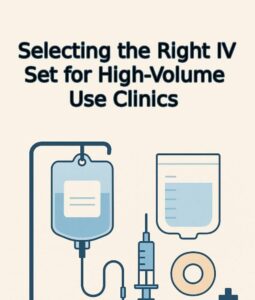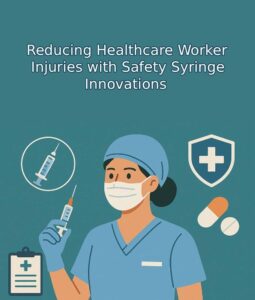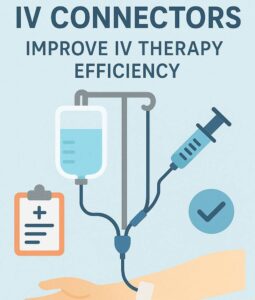In today’s healthcare landscape, navigating the debate reusable vs safety needle is essential. Clinicians, hospitals, and regulatory bodies demand needle safety certification to ensure devices meet global standards. The emergence of the ISO safety needle has reshaped expectations for protection, usability, and compliance. As you explore what makes a safety needle truly “safe,” we’ll unpack design innovations, global standards, and user-focused features that define modern medical safety. Know more..
1. The Reusable vs Safety Needle Debate
The age-old question of reusable vs safety needle isn’t just about cost—it’s about patient and staff safety. Traditional reusable needles often carry a higher risk of contamination or needlestick injuries. In contrast, safety needles are designed for single use, equipped with built‑in safety mechanisms that automatically shield the needle after injection. That difference is why needle safety certification processes often prioritize safety needles when setting global procurement policies.
Hospital procurement teams often weigh the cost of ownership: sterilization, tracking, and disposal for reusable needles versus the per‑unit cost of disposable safety needles. A lifecycle cost analysis typically shows that safety needles, though higher per unit, reduce staff injuries, contamination risk, and long-term liability. That makes the reusable vs safety needle choice a defining factor in healthcare safety strategy.
2. Essential Features of a Truly Safe Needle
For a safety needle to be considered “safe” in international markets, it must deliver on several fronts:
a. Auto‑Retractable or Shielded Tip
Modern safety needles—especially ISO safety needle models—use automatic retractable housings or sliding shields that lock immediately after use, preventing accidental sticks.
b. One‑Handed Activation
Clinicians need efficient tools. Whether during vaccinations or blood draws, devices that enable one‑handed activation while maintaining sterility elevate safety standards globally.
c. Clear Feedback Mechanisms
Audible “clicks,” visual indicators, or tactile resistance confirm that the safety feature has engaged. These fail‑safe signals are often required to achieve needle safety certification.
d. Ergonomic Design
Comfortable grips, color‑coded hubs, and standardized connectors help reduce user error. ISO‑mandated design specs—like those in ISO safety needle guidelines—ensure consistent ergonomics across markets.
e. Low‑Dose Dead Space
Needles with low internal volume prevent waste and reduce exposure to bloodborne pathogens during disposal—another critical detail considered in needle safety certification.
3. Why Needle Safety Certification Matters
a. Regulatory Trust & Market Access
Global bodies—FDA, CE, TGA—require evidence of needle safety certification before approving devices. Certifications reflect that devices comply with standards like ISO safety needle norms, enabling international sales.
b. Minimizing Occupational Hazards
Certified safety needles significantly reduce needlestick injuries. Studies show that rates drop 70–90% after adopting safety variants. That translates directly into fewer post‑exposure prophylaxis (PEP) cases and less staff downtime.
c. Insurance & Liability
Hospitals are liable for on‑the‑job injuries. Using needle safety certification backed products lowers organizational risk and often reduces malpractice insurance premiums.
d. Procurement Incentives
Many national health systems incentivize or mandate ISO safety needle devices. Government tenders increasingly favor certified safety needles over reusable options, making certification a market advantage.
4. The Role of ISO in Defining Safety Needles
a. ISO Standards Overview
Several ISO technical standards govern needle safety. Two key standards include:
- ISO 23908: “Needle‑safety devices for venepuncture and intravascular injection”—covers tactile feedback, activation reliability, and residual risk.
- ISO 11608‑1: Requirements for needle penetration profiles and mechanical safety.
These standards define performance thresholds essential for needle safety certification.
b. Testing Against ISO Safety Benchmarks
A device claiming to be an ISO safety needle must undergo rigorous testing: drop tests to ensure accidental activation doesn’t happen, activation force tests, and resistance to contamination—all documented in a technical file submitted to certification bodies.
c. Harmonization Across Borders
ISO safety needle standards are accepted across Europe, North America, Asia, Australia, and many emerging markets. That global harmonization enables manufacturers to streamline design and gain certification once, then sell worldwide.
5. Comparing Safety vs Reusable: Real‑World Use Cases
a. • Hospital In‑Patient Wards
Here the disposable safety needle’s one-hand activation prevents cross‑contamination between patients. In contrast, reusable vs safety needle debates often shift toward sterilization risk.
b. • Outpatient Clinics & Mass Vaccination Drives
Fast throughput and minimal training mean that ISO safety needle systems with passive protection (automatic shielding) outperform manual‑shielded reusable needles.
c. • Home Health & Self‑Injection
For insulin or biologics, easy-to-use safety mechanisms reduce injuries in non‑professional settings. The reusable vs safety needle argument becomes moot when safety trumps reuse.
d. • Low‑Resource Settings
Certification is key: disposable, ISO safety needle devices reduce complex sterilization protocols. NGOs and government programs increasingly require certified safety needles for procurement.
6. How Manufacturers Achieve Needle Safety Certification
a. Design & Risk Analysis
Manufacturers perform Failure Modes and Effects Analysis (FMEA), testing concepts against known hazards—using standards like ISO 14971 (risk management for medical devices) alongside ISO safety needle specs.
b. Prototyping & Laboratory Testing
Devices are tested through mechanical force, drop tests, biocompatibility assays, and packaging integrity evaluations. Only devices that meet or exceed thresholds obtain needle safety certification.
c. Clinical Validation
Usability studies with real users—clinicians or patients—confirm that the device works intuitively, regardless of environment. These studies focus heavily on slip‑and‑stick potential and activation reliability.
d. Regulatory Filings
For FDA 510(k), CE marking, or TGA approval, the needle safety certification dossier includes lab and clinical data, labeling, traceability, and manufacturability. Once approved, the device becomes eligible for international distribution.
7. Key Global Markets & Regulatory Comparisons
| Region | Requirements for Safety Needles | Notes |
| USA (FDA) | Requires premarket notification plus compliance with ISO 23908; enforces Needlestick Safety & Prevention Act | Adoption mandated in hospitals |
| EU (MDR) | CE marking via Notified Body using ISO safety standards; post‑market surveillance | Class IIb device category |
| Australia (TGA) | Follows EU standards; mandates needle safety certification for public procurement | Safety needles preferred |
| Japan (PMDA) | Local guidance aligns with ISO safety needle standards; must file clinical data | Passive devices favored |
| Brazil (ANVISA) | Requires ISO 11608 and ISO 23908 compliance; hospital policies enforce certification | Adoption growing in public and private sectors |
| India | CDSCO reviews ISO safety needle certification as part of product listings; state tenders often require it | Shift to safety needle is accelerating |
Safety needles that carry an ISO safety needle designation calibrated to local regulatory requirements are more likely to gain rapid adoption in each region.
8. Mainstream Trends Driving Safety Needle Adoption
a. Focus on Healthcare Worker Safety
With greater emphasis on occupational safety, certified devices reduce injuries and mental stress among healthcare workers.
b. Cost‑Savings via Fewer Exposures
Fewer PEP treatments and less lost work time yield cost offsets—certified safety needles justify their price premium.
c. Standardization of Global Supply Chains
Manufacturers selling ISO safety needle products can centralize inventory and reduce region‑specific variants.
d. Digital Traceability
Some advanced safety needles include RFID or QR codes that link to batch and certification info. This traceability is often part of needle safety certification reviews.
e. Environmental Considerations
While disposable, newer safety needles are designed to reduce plastic use and may use biodegradable materials—bridging the gap between reusable vs safety needle concerns.
9. Tips for Purchasing Certified Safety Needles
- Verify Certification – Always confirm that the device is officially ISO‑certified (e.g., ISO 23908). Ask manufacturers for a Certificate of Conformity.
- Evaluate User Feedback – Look for clinical study results or published data on user‑activation reliability.
- Check Ergonomics – Ensure a one‑handed mechanism, tactile/audible feedback, and color‑coding are included.
- Assess Cost vs Risk – Calculate total cost of ownership, including injury risk, disposal, and training.
- Confirm Regulatory Compliance – For multi‑country use, make sure the device has FDA clearance, CE marking, TGA or PMDA approval, etc.
- Inspect Labeling & Traceability – Prefilled safety needles with batch, lot, and expiration date printing help with recall management.
- Review Packaging & Sterility – Devices must arrive protected, sterile, and individually packaged—especially for ISO standards like ISO 11608.
10. The Future of ISO Safety Needles
- Fully Retractable Digital Needles – Micro‑electronics-enabled needles that transmit activation log info to EMRs.
- Smart Activation Analytics – Embedded sensors log each use, contributing to infection‑control oversight.
- Closed‑Loop Delivery Systems – Needles integrated with auto‑injectors for biologics and gene therapy—ISO‑certified and foolproof.
- Bio‑Based Materials – Eco‑friendly versions becoming mainstream in global healthcare procurement.
- Harmonized Certification – WHO‑led efforts aim to recognize needle safety certification universally, reducing duplicate testing.
Conclusion
When evaluating reusable vs safety needle options, the ultimate goal is safety—of patients, workers, and systems. A truly “safe” needle must combine smart design, rigorous needle safety certification, and alignment with ISO safety needle standards. That guarantees consistent performance across global markets, minimizes risk, and builds trust among users and regulators alike.
By verifying certification, assessing usability data, and prioritizing ISO safety needle features, stakeholders can confidently select devices that push care quality forward—while keeping people secure and systems compliant.






